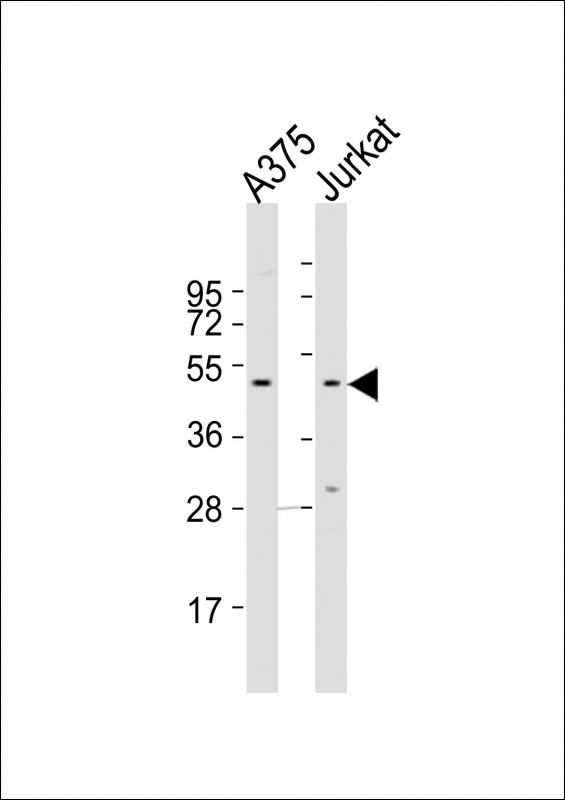CCR1 Antibody (N-term)
Purified Rabbit Polyclonal Antibody (Pab)
- 产品详情
- 实验流程
- 背景知识
Application
| WB, E |
|---|---|
| Primary Accession | P32246 |
| Reactivity | Human, Mouse |
| Host | Rabbit |
| Clonality | polyclonal |
| Isotype | Rabbit IgG |
| Calculated MW | 41173 Da |
| Gene ID | 1230 |
|---|---|
| Other Names | C-C chemokine receptor type 1, C-C CKR-1, CC-CKR-1, CCR-1, CCR1, HM145, LD78 receptor, Macrophage inflammatory protein 1-alpha receptor, MIP-1alpha-R, RANTES-R, CD191, CCR1, CMKBR1, CMKR1, SCYAR1 |
| Target/Specificity | This CCR1 antibody is generated from a rabbit immunized with a KLH conjugated synthetic peptide between 13-44 amino acids from the N-terminal region of human CCR1. |
| Dilution | WB~~1:2000 E~~Use at an assay dependent concentration. |
| Format | Purified polyclonal antibody supplied in PBS with 0.09% (W/V) sodium azide. This antibody is purified through a protein A column, followed by peptide affinity purification. |
| Storage | Maintain refrigerated at 2-8°C for up to 2 weeks. For long term storage store at -20°C in small aliquots to prevent freeze-thaw cycles. |
| Precautions | CCR1 Antibody (N-term) is for research use only and not for use in diagnostic or therapeutic procedures. |
| Name | CCR1 |
|---|---|
| Synonyms | CMKBR1, CMKR1, SCYAR1 |
| Function | Chemokine receptor that plays a crucial role in regulating immune cell migration, inflammation, and immune responses (PubMed:14991608). Contributes to the inflammatory response by recruiting immune cells, such as monocytes, macrophages, T-cells, and dendritic cells, to sites of inflammation for the clearance of pathogens and the resolution of tissue damage. When activated by its ligands including CCL3, CCL5-9, CCL13-16 and CCL23, triggers a signaling cascade within immune cells, leading to their migration towards the source of the chemokine (PubMed:15905581). For example, mediates neutrophil migration after activation by CCL3 leading to the sequential release of TNF-alpha and leukotriene B4 (By similarity). Also mediates monocyte migration upon CXCL4 binding (PubMed:29930254). Activation by CCL5 results in neuroinflammation through the ERK1/2 signaling pathway (By similarity). |
| Cellular Location | Cell membrane; Multi-pass membrane protein |
| Tissue Location | Widely expressed in different hematopoietic cells. |
For Research Use Only. Not For Use In Diagnostic Procedures.
Provided below are standard protocols that you may find useful for product applications.
BACKGROUND
Receptor for a C-C type chemokine. Binds to MIP-1-alpha, MIP-1-delta, RANTES, and MCP-3 and, less efficiently, to MIP-1- beta or MCP-1 and subsequently transduces a signal by increasing the intracellular calcium ions level. Responsible for affecting stem cell proliferation.
REFERENCES
Neote K.,et al.Cell 72:415-425(1993).
Gao J.-L.,et al.J. Exp. Med. 177:1421-1427(1993).
Nomura H.,et al.Int. Immunol. 5:1239-1249(1993).
Ko J.,et al.FASEB J. 18:890-892(2004).
Sung H.J.,et al.Exp. Mol. Med. 40:332-338(2008).
终于等到您。ABCEPTA(百远生物)抗体产品。
点击下方“我要评价 ”按钮提交您的反馈信息,您的反馈和评价是我们最宝贵的财富之一,
我们将在1-3个工作日内处理您的反馈信息。
如有疑问,联系:0512-88856768 tech-china@abcepta.com.























 癌症的基本特征包括细胞增殖、血管生成、迁移、凋亡逃避机制和细胞永生等。找到癌症发生过程中这些通路的关键标记物和对应的抗体用于检测至关重要。
癌症的基本特征包括细胞增殖、血管生成、迁移、凋亡逃避机制和细胞永生等。找到癌症发生过程中这些通路的关键标记物和对应的抗体用于检测至关重要。 为您推荐一个泛素化位点预测神器——泛素化分析工具,可以为您的蛋白的泛素化位点作出预测和评分。
为您推荐一个泛素化位点预测神器——泛素化分析工具,可以为您的蛋白的泛素化位点作出预测和评分。 细胞自噬受体图形绘图工具为你的蛋白的细胞受体结合位点作出预测和评分,识别结合到自噬通路中的蛋白是非常重要的,便于让我们理解自噬在正常生理、病理过程中的作用,如发育、细胞分化、神经退化性疾病、压力条件下、感染和癌症。
细胞自噬受体图形绘图工具为你的蛋白的细胞受体结合位点作出预测和评分,识别结合到自噬通路中的蛋白是非常重要的,便于让我们理解自噬在正常生理、病理过程中的作用,如发育、细胞分化、神经退化性疾病、压力条件下、感染和癌症。






